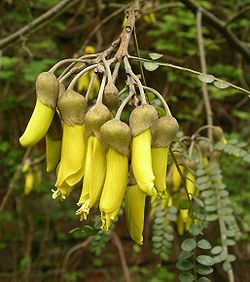| Sophoreae | |
|---|---|
 | |
| Sophora tetraptera | |
| Scientific classification | |
| Kingdom: | Plantae |
| Clade: | Tracheophytes |
| Clade: | Angiosperms |
| Clade: | Eudicots |
| Clade: | Rosids |
| Order: | Fabales |
| Family: | Fabaceae |
| Subfamily: | Faboideae |
| Clade: | Meso-Papilionoideae |
| Clade: | Genistoids |
| Clade: | Core Genistoids |
| Tribe: | Sophoreae (Spreng. ex DC. 1825) Cardoso et al. 2013 [1] [2] |
| Genera | |
See text | |
| Synonyms [2] | |
| |
The tribe Sophoreae is one of the subdivisions of the plant family Fabaceae. Traditionally this tribe has been used as a wastebasket taxon to accommodate genera of Faboideae which exhibit actinomorphic, rather than zygomorphic floral symmetry and/or incompletely differentiated petals and free stamens. [2] [3] [4] Various morphological [5] [6] [7] [8] and molecular [9] [10] [11] [12] [13] analyses indicated that Sophoreae as traditionally circumscribed was polyphyletic. [14] This led to a re-circumscription of Sophoreae, which resulted in the transfer of many genera to other tribes (Amburaneae, Angylocalyceae, Baphieae, Camoensieae, the Cladrastis clade, Exostyleae, Leptolobieae, Ormosieae, Podalyrieae, and the Vataireoids). [2] This also necessitated the inclusion of two former tribes, Euchresteae and Thermopsideae, in the new definition of Sophoreae. [2] [15] [16] [17] [18] Tribe Sophoreae, as currently circumscribed, consistently forms a monophyletic clade in molecular phylogenetic analyses. [2] [12] [17] [19] [20] [21] [22] The Sophoreae arose 40.8 ± 2.4 million years ago (in the Eocene). [8] [23]
Contents
Description of morphological synapomorphies has yet to be undertaken, but members of this tribe can be distinguished by the relatively simple flowers, unspecialized pinnate leaves, accumulation of quinolizidine alkaloids, [24] and the presence of free stamens. [2] The tribe does have a node-based definition: the crown clade originating from the most recent common ancestor of Bolusanthus speciosus (Bolus) Harms and Sophora davidii (Franch.) Pavol.. [23]